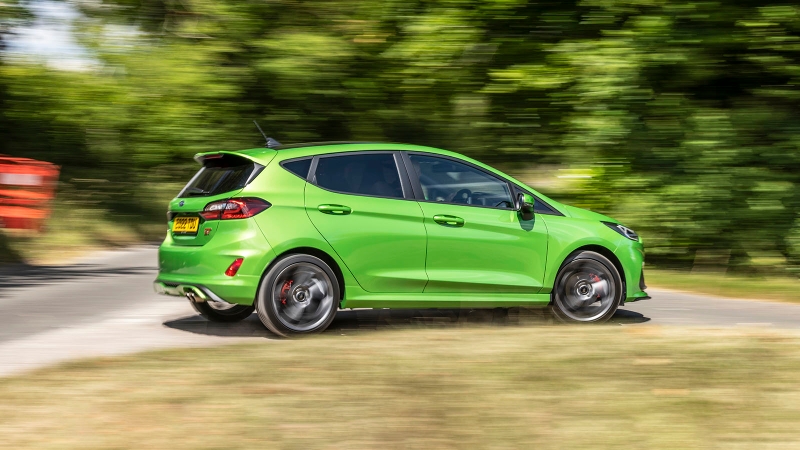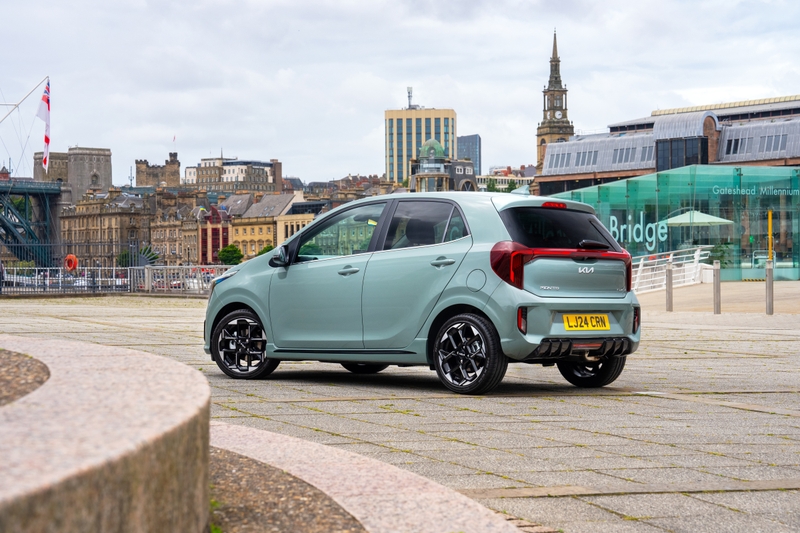










Abarth 595 Review

Modern hot hatches like the Volkswagen Polo GTI and Ford Fiesta ST are faster and easier to live with than ever before. They've also lost a bit of the wild side older hot hatches had.
That's what makes the Abarth 595 such a breath of fresh air. This is a hot hatch – distilled. From the manic turbocharged engine, to the flamboyant body styling and firm, race-car driving experience, the 595 makes every drive feel like a special event.
- Old-school hot hatch thrills
- Dramatic styling inside and out
- Remarkably affordable
- Firm standard suspension
- Some cheap materials in the cabin
- Not as refined as some rivals
Should I buy an Abarth 595?
Tightening emissions rules means there aren't as many hot hatches on sale as there once were. Rivals like the Ford Fiesta ST and Renaultsport Clio might've thrown in the towel, but the Abarth 595 is still available after more than 15 years on sale.
Before bowing out of the market, the Abarth's rivals had become faster, smarter and better equipped, but they sacrificed a little soul in the process. In practice, that meant they were comfier and more refined to live with, but it felt as if the focus had been taken off driving fun, with muted exhaust notes and softened handling, and some models even ditching the all-important manual gearbox, too.
None of those complaints apply to the little Abarth, however. This is a shouty, snarly sports car with hard-edged handling, a raucous engine and a full suite of go-faster gear so it looks the part, too. All versions have a manic character that urges you to lean into the turbo boost at every opportunity but, as you head up the range, you get some serious mechanical upgrades to enhance the 595's on-track performance.
It does demand some compromises, however. Being based on the Fiat 500 means the 595 is a properly small car and the rear seats are better used as extra storage than for their intended purpose. It's loud, too, and quite firm over poor road surfaces, so long journeys can be a chore if you run out of songs on your playlist to drown out the noise. And, while the cabin comes with plenty of exciting go-faster parts, you'll still find evidence that this is a cheap car underneath, with scratchy plastics and hard surfaces featured lower down in the interior.
Regardless of those shortcomings, the Abarth fares extremely well against its competition – because there basically isn't any competition at this price point. As a used car, the Abarth doesn't just undercut other hot hatches, but plenty of regular-temperature hatches, too. The only ballpark alternative is the – admittedly delightful – Suzuki Swift Sport, but it's more of a warm hatch and can't keep up with the more powerful 595 in a straight line. For the price, few cars can match the Abarth's hilarious driving experience.
Interior and technology

There's an odd duality to the Abarth 595's cabin. The brand has added lots of special parts to leave you in no doubt this is a real-deal performance car. You'll spot grippy perforated leather on the steering wheel as well as a 12-o'clock mark like a rally car, plus metal pedals and, on higher-end models, an aluminium ball gear shifter that feels wonderful under your hand.
The seats, too, double down on the car's sporty pretensions. Even entry-level 595s have body-hugging sports seats that look and feel great, while pricier models get Sabelt-branded racing bucket seats trimmed in suede – a feature you'd normally find in much more exotic and expensive cars.
However, cast your eye to the lesser used and touched parts of the cabin and you'll find lots of evidence that this was once a cheap-and-cheerful Fiat 500 underneath. There's hard, grey plastic on the door panels and lower dashboard, as well as a few spots with exposed, painted bodywork – not something you'd find in rivals from Ford and Volkswagen.
All recent versions include a seven-inch touchscreen infotainment system. This is a substantial upgrade on the basic stereo featured in earlier Abarth models, but is still fairly small and low resolution compared to the best in class. Apple CarPlay and Android Auto are included on mid-range Pista models and up but, from 2022 onwards, they became standard equipment across the lineup. Persistent on-screen shortcut buttons make jumping between functions fairly easy, and the physical volume and track selection knobs further improve usability.
Older Abarth models had unique concentric driver's dials, with the rev counter sat inside the speedo so the needles would chase each other up the dial as you accelerated. These have since been replaced by a round digital screen. This has sharp graphics and shows more information than the older setup but, to our old-fashioned eyes, it lacks the charm of the old analogue dials. You also get a whacking great turbo boost gauge next to the driver's dials that flashes for you to shift as you hit the redline, helping add even more visual drama.
Practicality

Clearly, this isn't the Abarth's strongest suit. At less than 3.7 metres long – shorter than a Hyundai i10 – the 595 isn't going to work as a family car. If, however, you're buying as a single person or a couple and rarely carry rear-seat passengers, the 595 should fit into your life.
There are just two rear seats and they're very cramped. You are treated to the same sporty upholstery as the front seats, including plush leather and suede options, but you sit upright with little support to speak of. There's almost no rear legroom if front-seat occupants are anywhere near six-foot tall, either, so these seats are best thought of as occasional spots for passengers on short journeys. Access is tricky, too – the handle to fold the front seats is hard to reach, and you'll need to be fairly flexible to squeeze through the gap once they're moved out the way.
Treat it mainly as a two-seater and the 595 makes much more sense. There's enough space in the front for taller adults to sit comfortably, and the sports seats themselves are mounted a touch higher than you might expect, giving you decent front-end visibility. Annoyingly, you can't adjust the standard seats very far down, and you can't adjust the optional Sabelt seats for height at all – although they do give the cabin a more serious race-car feel. There's also no reach adjustment for the steering wheel, with rake being the only option. As a result, some drivers might need to sit fairly upright to get their arms and legs in a comfy position.
There's 185 litres of boot space, which isn't much by anyone's standards. You'll be able to fit two or three big shopping bags back there with the rear seats up but that's about it. Fold the rear seats, however, and there's 550-litres of space to work with – plenty for a couple's holiday luggage or a trip to the tip. Boot access is reasonably easy on hatchback models but 595C convertibles have a cramped boot flap to allow space for the rollback fabric soft-top.
Engines and performance

There's just one engine available in the 595 – a 1.4-litre turbocharged petrol engine – but it comes with a choice of power outputs. Almost all versions are paired with a five-speed manual gearbox and this suits the car best. An 'MTA' automatic gearbox is optionally available, but its shifts are a bit clunky and it slightly dulls the driving experience. All versions claim to average more than 40mpg but, in the real world, you'll need to work hard to crest 35mpg.
Whatever model you choose, the 595 is a loud car. The engine noise is aggressive and present at all speeds, so you'll need to turn the stereo up to muffle the drone on longer journeys. It does make the car feel exciting, however, whether you're burbling menacingly down the high street, or enjoying the angry snarl as it launches up a motorway slip road. Higher-end 595 trims include the optional Record Monza exhaust – marked out by its quad tailpipes – which has a flap that opens at higher engine speeds for an even more riotous sound.
Entry-level 595s make 145hp and complete the 0-62mph run in 7.8 seconds. That feels like plenty of power in a car this small, although most real-deal hot hatches will easily outpace it in a drag race. Stepping up to the 165hp version drops the 0-62mph time to 7.3 seconds and helps the car feel noticeably more manic under full throttle. Range-topping Competizione and Esseesse versions push power all the way to 180hp, with a 6.7-second 0-62mph time. Again, the difference is only really noticeable under full throttle, where these versions feel seriously quick if you have a heavy right foot.
Driving and comfort

Abarth has, wisely, worked hard to make the 595 feel like a race car, while actually setting the car up to be quite forgiving on real roads. It's grippy and stable, despite its super-short wheelbase, and isn't prone to sudden under or oversteer if you misjudge a corner. Despite its neutral handling balance, it's still very agile thanks to its size. The car uses clever braking tech to send torque to the outside front wheel in a corner, helping push you harder towards the apex.
The engine is the star of the show, however. It's loud and in-your-face – dominating the driving experience and urging you to lean harder on the throttle. There's a unique charm to the way the 595's engine hits boost as it pulls away from a standstill, almost giving you the sensation the front axle is trying to wrench itself free from the car, such is the power being sent to the wheels.
It's worth going through the hassle of finding a comfy driving position, too. You'll notice the handsome metal pedals are well placed for heel-and-toe braking, and the dashboard-mounted gear shifter is just a graceful flick of the wrist away from the steering wheel.
Every 595 is set up quite firm to resist body roll in corners. Standard 595s can get quite jiggly over potholes or manhole covers, and you might have to slow down more than you expect for speed bumps. The upgraded Koni suspension fitted to Competizione and Esseesse models uses clever frequency-selective damping technology to help the car ride a little more gracefully over bumps – we think this is well worth the upgrade.
























































